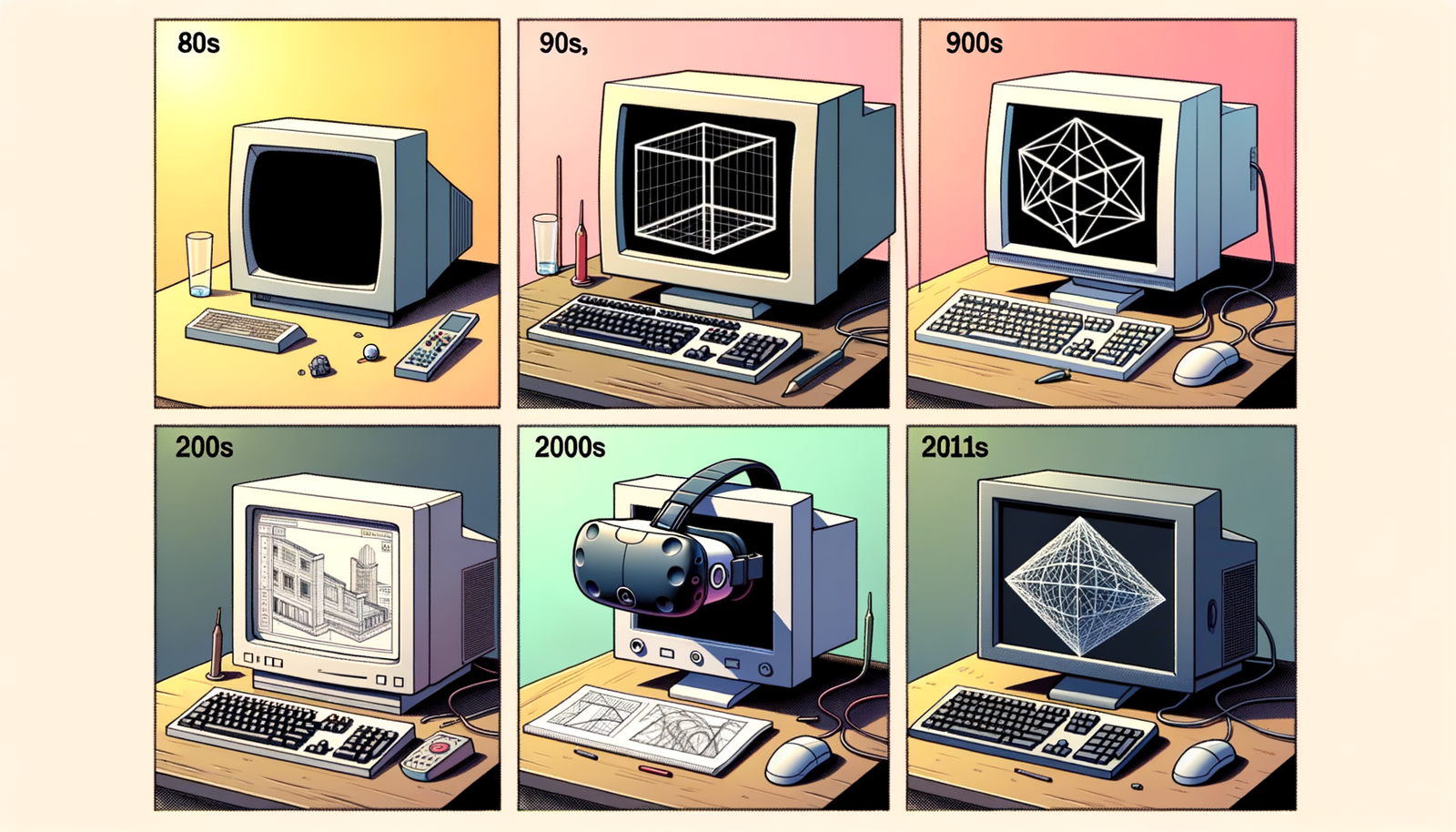Your Cart is Empty
Customer Testimonials
-
"Great customer service. The folks at Novedge were super helpful in navigating a somewhat complicated order including software upgrades and serial numbers in various stages of inactivity. They were friendly and helpful throughout the process.."
Ruben Ruckmark
"Quick & very helpful. We have been using Novedge for years and are very happy with their quick service when we need to make a purchase and excellent support resolving any issues."
Will Woodson
"Scott is the best. He reminds me about subscriptions dates, guides me in the correct direction for updates. He always responds promptly to me. He is literally the reason I continue to work with Novedge and will do so in the future."
Edward Mchugh
"Calvin Lok is “the man”. After my purchase of Sketchup 2021, he called me and provided step-by-step instructions to ease me through difficulties I was having with the setup of my new software."
Mike Borzage
Design Software History: The Evolution of TurboCAD: Pioneering Affordable and Accessible CAD Solutions
August 10, 2024 5 min read


The Origins and Early Development of TurboCAD
Background and Context
The landscape of CAD (Computer-Aided Design) software in the late 1980s was a rapidly evolving field. During this time, the concept of using computers for design and drafting was still relatively new, with many companies exploring how technology could revolutionize traditional manual drafting methods. The industry saw a wide array of burgeoning CAD tools, each seeking to establish a foothold in a competitive market dominated by early leaders such as AutoCAD and CATIA.
The late 1980s marked a pivotal moment in the history of design software, with significant advancements in computer hardware making sophisticated design tools more accessible. This period was characterized by a quest to enhance productivity and precision in design processes, which had a profound impact on architecture, engineering, and manufacturing industries.
The Founding of TurboCAD
TurboCAD was developed by IMSI/Design, a company known for its commitment to providing affordable yet powerful design tools. The inception of TurboCAD can be traced back to the vision of a few key individuals who recognized the potential of creating a versatile CAD software that was both user-friendly and cost-effective. Among these pioneers were Bob Mayer, who played an instrumental role in shaping the software's direction, and Royal Farros, whose entrepreneurial spirit drove the company's early growth.
The initial goals for TurboCAD were ambitious: to create a CAD application that could compete with existing giants while being accessible to a broader audience, including small businesses and individual designers. The vision was to democratize access to high-quality design tools, thereby fostering innovation across various fields.
Early Features and Capabilities
The first version of TurboCAD, released in 1986, was a 2D drafting application that quickly gained attention for its robust feature set and affordability. Key features that set TurboCAD apart from its competitors included:
- Intuitive User Interface: TurboCAD's interface was designed to be user-friendly, reducing the learning curve for new users.
- Comprehensive Toolset: The software offered a wide range of drawing and editing tools that catered to diverse design needs.
- Affordability: Priced significantly lower than many competing products, TurboCAD made professional-grade CAD software accessible to smaller firms and individual designers.
The initial reception of TurboCAD was positive, with users appreciating its balance of functionality and cost. Feedback from the design community highlighted the software's ease of use and versatility, which helped TurboCAD establish a loyal user base early on.
Evolution of TurboCAD: Milestones and Technological Advancements
Significant Updates and Versions
Over the years, TurboCAD has undergone numerous updates, each adding new features and enhancements that kept it competitive in the ever-evolving CAD market. Key milestones in its development include:
- Introduction of 3D Modeling: In the mid-1990s, TurboCAD introduced 3D modeling capabilities, allowing users to create and manipulate three-dimensional objects. This was a significant leap that broadened the software's appeal to industries requiring complex 3D designs.
- Parametric Design: The integration of parametric design features enabled users to define relationships between objects, making the design process more flexible and efficient. This was particularly valuable for iterative design workflows.
- Regular Updates: TurboCAD consistently released new versions, incorporating user feedback and technological advancements to enhance functionality and performance.
Technological Innovations
TurboCAD has been at the forefront of several technological innovations that have shaped the CAD industry. Some of these innovations include:
Advanced Rendering: TurboCAD introduced advanced rendering capabilities that allowed users to create photorealistic images of their designs. This feature was crucial for product visualization and presentation, enabling designers to showcase their work more effectively.
Solid Modeling: The addition of solid modeling tools allowed users to create complex, high-precision models essential for engineering and manufacturing applications. This placed TurboCAD on par with some of the leading CAD software in the market.
Improved User Interface: Over the years, TurboCAD's user interface has undergone significant improvements, making it more intuitive and customizable. These enhancements have played a vital role in boosting productivity and user satisfaction.
Market Penetration and Adoption
TurboCAD's market presence has grown steadily since its inception. The software has been adopted by a wide range of industries, including architecture, engineering, and manufacturing. Its affordability and versatility have made it a popular choice for small businesses and individual designers, as well as larger organizations.
The adoption of TurboCAD in various sectors can be attributed to its ability to deliver professional-grade features at a fraction of the cost of other leading CAD tools. This has enabled many businesses to leverage advanced design capabilities without significant financial investment.
Impact and Contributions to the Design Software Industry
Influence on CAD Standards and Practices
TurboCAD has made significant contributions to setting industry standards and influencing design practices. By providing a comprehensive and affordable CAD solution, TurboCAD has helped popularize the use of CAD tools across different sectors, contributing to the widespread adoption of digital design methodologies.
Moreover, TurboCAD's continuous innovation and feature enhancements have set benchmarks for other CAD software, pushing the industry towards more advanced and user-friendly solutions. Its impact is evident in the standardization of many design practices and the emphasis on accessibility and affordability in the CAD market.
Educational and Professional Impact
TurboCAD has played a crucial role in education and professional training. Many educational institutions have incorporated TurboCAD into their curricula, providing students with hands-on experience in using CAD software. This has equipped a generation of designers and engineers with the skills needed to excel in their respective fields.
Testimonials from professionals highlight the transformative impact TurboCAD has had on their careers. Many users have credited the software with enhancing their design capabilities and enabling them to take on more complex projects. The availability of affordable CAD tools like TurboCAD has also opened up opportunities for freelance designers and small businesses to compete in a competitive market.
Integration with Other Technologies
TurboCAD's compatibility with other design tools and technologies has been a key factor in its success. The software supports a wide range of file formats, allowing users to integrate TurboCAD with other applications seamlessly. This interoperability has made TurboCAD a versatile tool in multi-disciplinary projects.
The integration of TurboCAD with emerging technologies such as additive manufacturing and virtual reality (VR) has further expanded its relevance. Users can create designs in TurboCAD and directly use them in 3D printing or immersive VR environments, showcasing the software's adaptability to new technological trends.
Future Prospects and Legacy of TurboCAD
Current State and Recent Developments
The latest version of TurboCAD continues to build on its legacy of innovation and user-centric design. Recent developments include enhanced 3D modeling capabilities, improved rendering engines, and advanced parametric design features. These updates have further solidified TurboCAD's position as a leading CAD solution for both professionals and hobbyists.
Additionally, TurboCAD has embraced cloud-based technologies, allowing for collaborative design and remote access to projects. This shift towards cloud computing reflects the industry's broader trend towards greater connectivity and flexibility in design workflows.
Future Roadmap and Innovations
Looking ahead, TurboCAD's roadmap includes several exciting developments aimed at maintaining its competitive edge. Planned updates focus on incorporating artificial intelligence (AI) and machine learning to enhance design automation and predictive capabilities. These innovations promise to streamline workflows and reduce the time required for complex design tasks.
TurboCAD is also exploring the integration of augmented reality (AR) to provide users with immersive design experiences. By leveraging AR, designers can visualize their projects in real-world environments, enhancing their ability to make informed design decisions.
Legacy and Long-Term Impact
Reflecting on TurboCAD's enduring legacy, its contributions to the design software industry are profound. TurboCAD has played a pivotal role in democratizing access to powerful design tools, enabling a diverse range of users to leverage advanced CAD capabilities. This democratization has fueled innovation and creativity across various fields, from architecture to product design.
TurboCAD's long-term impact is evident in the way it has influenced design processes and industry standards. By consistently delivering high-quality, affordable CAD solutions, TurboCAD has set a precedent for other software developers, driving the industry towards more inclusive and accessible design tools.
Also in Design News

Cinema 4D Tip: Constraint-Based Animation with PSR, Parent, and Aim
December 07, 2025 2 min read
Read More
V-Ray Tip: Proximity Dirt and Wear Masks with VRayDistanceTex
December 07, 2025 2 min read
Read More
AutoCAD Tip: Isolate Objects for Focused, Non-Destructive Editing
December 07, 2025 2 min read
Read MoreSubscribe
Sign up to get the latest on sales, new releases and more …


